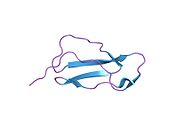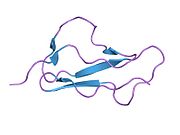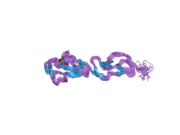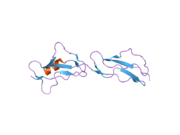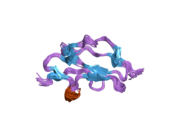Factor H
| CFH | |||
|---|---|---|---|
Gene ontology | |||
| Molecular function | |||
| Cellular component | |||
| Biological process | |||
| Sources:Amigo / QuickGO | |||
Ensembl | |||||||||
|---|---|---|---|---|---|---|---|---|---|
| UniProt | |||||||||
| RefSeq (mRNA) | |||||||||
| RefSeq (protein) | |||||||||
| Location (UCSC) | Chr 1: 196.65 – 196.75 Mb | Chr 1: 140.01 – 140.11 Mb | |||||||
| PubMed search | [3] | [4] | |||||||
| View/Edit Human | View/Edit Mouse |
Factor H (FH) is a member of the regulators of complement activation family and is a
The ability of Factor H to exert its protective action on self cells and self surfaces is thought to be the result of Factor H having the ability to adopt conformations with lower or higher activities as a cofactor for C3 cleavage or decay accelerating activity.
Structure
The molecule is made up of 20
Clinical significance
Due to the central role that factor H plays in the regulation of complement, there are a number of clinical implications arising from aberrant factor H activity. Overactive factor H may result in reduced complement activity on pathogenic cells – increasing susceptibility to microbial infections. Underactive factor H may result in increased complement activity on healthy host cells – resulting in autoimmune diseases. It is not surprising, therefore, that rare
In 2005, several independent research groups identified an SNP in CFH, which results in the protein change p.Y402H, as a risk factor for AMD present in around a third of Europeans.
Variation in other genes of the regulators of complement activation locus, such as complement factor H-related genes, as well as in other complement proteins (e.g. factor I, C2/factor B, and C3) have also been associated with greater AMD risk.[30] The current theory is that complement dysregulation is a key driver of chronic inflammation in AMD.[30]
Atypical hemolytic uremic syndrome
Schizophrenia
Alterations in the immune response are involved in pathogenesis of many neuropsychiatric disorders including schizophrenia. Recent studies indicated alterations in the complement system, including those which may result in the overactivation of the alternative complement pathway, may predispose to schizophrenia. For example, the CFH SNP rs424535 (2783-526T>A) was positively associated with schizophrenia.[34]
Ischemic stroke
It was found that rs800292(184G >A) SNP was positively associated with stroke and rs800912 minor allele of the CFH gene might be considered as a risk factor for ischemic stroke.[34]
Recruitment by pathogens
Given the central role of factor H in protecting cells from complement, it is not surprising that several important human
Interactions
Factor H has been shown to
Recombinant production
Biologically active Factor H has been produced by
Potential use as a therapeutic drug
Gemini Therapeutics Inc. is a Massachusetts based precision medicine company focused on the development of new therapies through a deeper understanding of disease. Based on the biological activity of human factor H, Gemini is developing a recombinant human factor H protein, GEM103, for the treatment of dry AMD. Gemini recently announced the completion of enrollment in a Phase 2a Trial of GEM103 in Dry Age-Related Macular Degeneration (AMD) in Patients with High-Risk Genetic Variants. Top line data are expected in 1H 2021.
References
- ^ a b c GRCh38: Ensembl release 89: ENSG00000000971 – Ensembl, May 2017
- ^ a b c GRCm38: Ensembl release 89: ENSMUSG00000026365 – Ensembl, May 2017
- ^ "Human PubMed Reference:". National Center for Biotechnology Information, U.S. National Library of Medicine.
- ^ "Mouse PubMed Reference:". National Center for Biotechnology Information, U.S. National Library of Medicine.
- PMID 23376722.
- PMID 18436830.
- PMID 18596911.
- PMID 22504643.
- PMID 22104107.
- ^ PMID 26459349.
- PMID 10904114.
- PMID 15163532.
- PMID 18684951.
- PMID 18252712.
- PMID 1533152.
- PMID 17360715.
- PMID 23017427.
- PMID 19835885.
- PMID 1829116.
- PMID 8331663.
- PMID 22389686.
- PMID 16533809.
- PMID 16601698.
- PMID 17893204.
- PMID 19503104.
- PMID 21317894.
- PMID 21285368.
- ^ PMID 11399083.
- S2CID 25095717.
- ^ S2CID 226274874.
- PMID 22019782.
- PMID 17548524.
- PMID 21148255.
- ^ .
- PMID 19850343.
- PMID 9480984.
- ^ S2CID 207007297.
- PMID 9291131.
- PMID 11367533.
- PMID 20723134.
- PMID 21146613.
Further reading
- Bradley DT, Zipfel PF, Hughes AE (June 2011). "Complement in age-related macular degeneration: a focus on function". Eye. 25 (6): 683–693. PMID 21394116.
- Kardys I, Klaver CC, Despriet DD, Bergen AA, Uitterlinden AG, Hofman A, et al. (April 2006). "A common polymorphism in the complement factor H gene is associated with increased risk of myocardial infarction: the Rotterdam Study". Journal of the American College of Cardiology. 47 (8): 1568–1575. PMID 16630992.
- Pío R, Elsasser TH, Martínez A, Cuttitta F (April 2002). "Identification, characterization, and physiological actions of factor H as an adrenomedullin binding protein present in human plasma". Microscopy Research and Technique. 57 (1): 23–27. S2CID 37608883.
- Walport MJ (April 2001). "Complement. First of two parts". The New England Journal of Medicine. 344 (14): 1058–1066. PMID 11287977.
- Walport MJ (April 2001). "Complement. Second of two parts". The New England Journal of Medicine. 344 (15): 1140–1144. PMID 11297706.
External links
- GeneReviews/NCBI/NIH/UW entry on Atypical Hemolytic-Uremic Syndrome
- GeneReviews/NCBI/NIH/UW entry on Dense Deposit Disease/Membranoproliferative Glomerulonephritis Type II
- OMIM entries on Atypical Hemolytic-Uremic Syndrome
- Complement+Factor+H at the U.S. National Library of Medicine Medical Subject Headings (MeSH)

